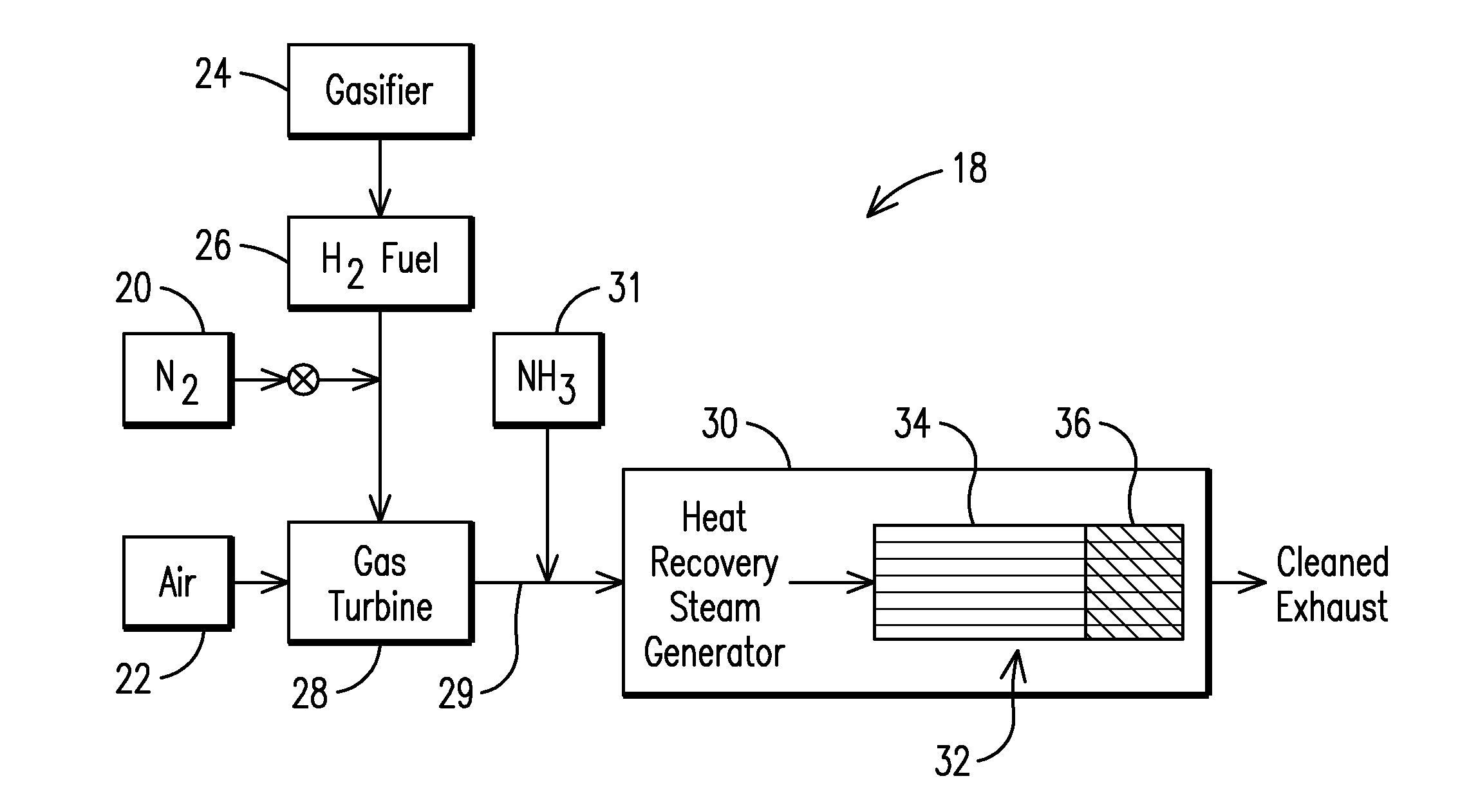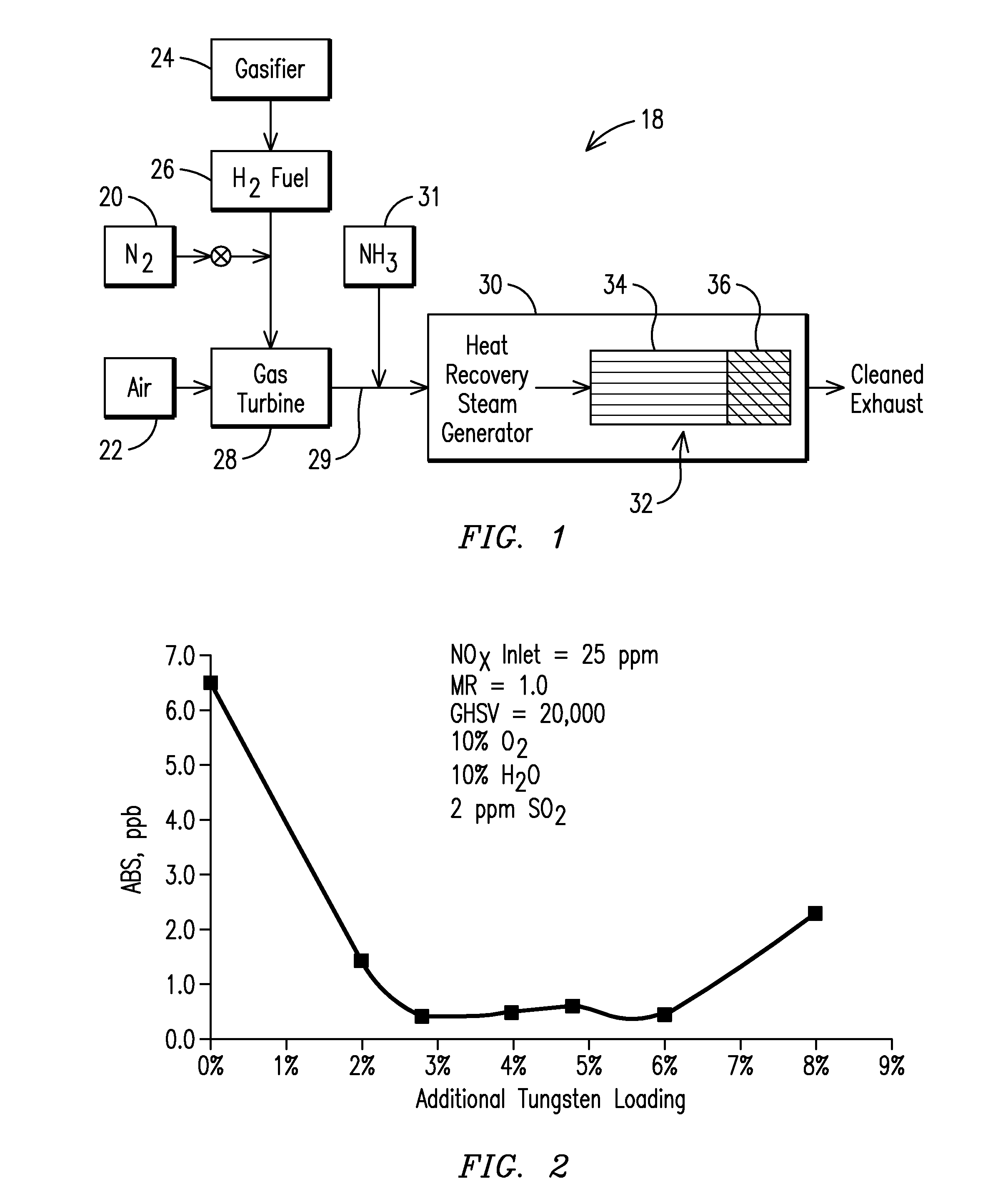SELECTIVE CATALYTIC REDUCTION SYSTEM AND PROCESS FOR CONTROL OF NOx EMISSIONS IN A SULFUR-CONTAINING GAS STREAM
a catalytic reduction system and sulfur-containing gas technology, applied in the direction of physical/chemical process catalysts, separation processes, bulk chemical production, etc., can solve the problems of severe corrosion of heat exchange elements downstream of scr, the development of a flexible fuel process to reduce nosub>x/sub>, co and hydrocarbon emissions,
- Summary
- Abstract
- Description
- Claims
- Application Information
AI Technical Summary
Benefits of technology
Problems solved by technology
Method used
Image
Examples
example 1
[0026]The following is an example of catalyst preparation with additional amount of tungsten (W) in the reducing-plus-oxidizing portion 36. A solution was prepared by adding ammonium metatungstate (Aldrich) to DI water in a 2000 mL beaker. The monolith cores of a extruded conventional SCR catalyst system with 7% by wt. tungsten were dipped in the solution to achieve a 10% by wt. tungsten loading. Blocks were microwave dried and calcined at 450° C. for 2 hours. A palladium / platinum metal solution was prepared by adding to a beaker tetraammine palladium chloride solution and a solution of tetraammine platinum chloride. Monolith blocks were dipped in said solutions yielding an average of 5 g Pt Pd / ft3. Blocks were further microwaved, dried and calcined at 450° C. for 2 hours to provide a PERCW catalyst bed that includes tungsten oxide after calcination. It is appreciated that the catalyst beds described herein may thus be provided by adding tungsten and an oxidizing catalyst, e.g. plat...
example 2
[0027]As shown in Table 1, the present inventor found that the presence of an additional amount of tungsten in a conventional industrial SCR (baseline comparative catalyst) did not lead to any significant changes in the catalyst performance with regard to formation of ABS (Table 1). The baseline SCR comparative catalyst (SCR) had the following composition: 1.6% V / 7% W / 3.0% Si / 36.5% Ti. The SCR +3.5% W catalyst system shown in Table 1 included an additional WO3 (additional 3.5 wt % tungsten). The inclusion of the additional WO3 in the SCR catalytic bed did not lead to any significant changes in the catalyst performance with regard to the formation of ABS. In the PERC catalyst system, the reducing only portion 34 of the PERC bed had the same as baseline SCR composition, but a reducing-plus-oxidizing portion 36 of the PERC catalyst was provided and had a baseline SCR composition with addition of 5 g / ft3 Pd and 5 g / ft3 Pt. In the PERCW catalyst system, there was provided an additional ...
example 3
[0029]The inventor has found that including the additional tungsten in the downstream reducing-plus-oxidizing portion resulted in a substantial decrease in ABS formation at particular concentrations. As shown in FIG. 2 and Table 2, for example, the present inventor has found that by providing an additional 2-8 wt. % of tungsten in the downstream reducing-plus-oxidizing portion 36 relative to the reducing only portion 34 resulted in a marked drop in ABS formation (below 2.0 ppb ABS and typically below 1.0 ppb) relative to a uniform distribution of tungsten throughout the catalytic bed 32. Exemplary results of catalysts were tested under IGCC operating conditions in the pilot scale testing rig (catalytic block 150×150×300 mm) and are illustrated in Table 2 below. In this instance, the baseline SCR comparative catalyst (SCR in Table 2) had the following composition: 1.6% V / 7.2% W / 3.0% Si / 36.5% Ti. The reducing only portion 36 of the catalytic bed 32 had the same as baseline SCR compos...
PUM
| Property | Measurement | Unit |
|---|---|---|
| Fraction | aaaaa | aaaaa |
| Fraction | aaaaa | aaaaa |
| Ratio | aaaaa | aaaaa |
Abstract
Description
Claims
Application Information
 Login to View More
Login to View More - R&D
- Intellectual Property
- Life Sciences
- Materials
- Tech Scout
- Unparalleled Data Quality
- Higher Quality Content
- 60% Fewer Hallucinations
Browse by: Latest US Patents, China's latest patents, Technical Efficacy Thesaurus, Application Domain, Technology Topic, Popular Technical Reports.
© 2025 PatSnap. All rights reserved.Legal|Privacy policy|Modern Slavery Act Transparency Statement|Sitemap|About US| Contact US: help@patsnap.com


